‘Sad to see the history and culture of our great country being ripped apart with the removal of our beautiful statues and monuments. You … can’t change history, but you can learn from it.’: President Trump, Twitter, 17 August 2017
‘History is about remembering the past, but it is also about choosing to forget …’: historian Margaret Macmillan, The Uses and Abuses of History (2007)
‘Forgetting some aspects of the past is as much a part of historical understanding as remembering others.’: historian Eric Foner, The Nation (2011)
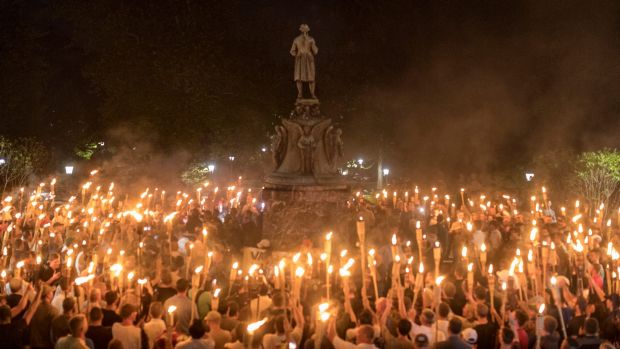 White nationalists at Thomas Jefferson statue, Charlottesville (Fairfax/New York Times)
White nationalists at Thomas Jefferson statue, Charlottesville (Fairfax/New York Times)
Events in Charlottesville, Virginia, were triggered and have been followed by moves to demolish memorials to heroes of the Confederate South, the losing side in the American Civil War 1861-65. The history of these memorials is complex and there is a lot more to them than remembrance of that war: some of the articles point out that many of the memorials were built between the 1890s and the 1950s, as expressions of white supremacy. (The Lee statue in Charlottesville went up in 1924.) White supremacy as a concept did not die at Appomattox. (This graphic shows the great upsurge in Confederate monuments in the early 20th century.)
There has been a mass of commentary on these recent events but what piqued our interest were statements about the significance of memorialisation, the difference between the past and history, and the choices people make about history. Here are some we noticed:
- ‘As for the idea of erasing history, it’s a possibility most scholars do not take lightly. But James Grossman, the executive director of the American Historical Association, said that Mr. Trump’s comments failed to recognize the difference between history and memory, which is always shifting. When you alter monuments, “you’re not changing history”, he said. “You’re changing how we remember history.”‘ (Jennifer Schuessler, New York Times, 15 August 2017).
- ‘[Some Southern whites] cling to the idea that the memory of the Confederacy is about “heritage, not hate” … The statues are only the most obvious instances of a deep, stubborn reality about the South. The symbols of the Confederacy, and therefore of white supremacy, are everywhere a part of life, ingrained in commutes and school schedules and college applications, as seemingly natural and pervasive as water, so that you never think to do anything about them. It’s time that changed.’ (Clay Risen, New York Times, 18 August 2017)
- ‘Ongoing racial disparities in incarceration, educational attainment, police brutality, hiring practices, access to health care, and, perhaps most starkly, wealth, make it clear that these monuments do not stand somehow outside of history. Racism and white supremacy, which undoubtedly continue today, are neither natural nor inevitable … As cities all over the South are realizing now, we are not in need of added context. We are in need of a new context – one in which the statues have been taken down.’ (Jack and Warren Christian, descendants of General ‘Stonewall’ Jackson, Slate, 16 August 2017)
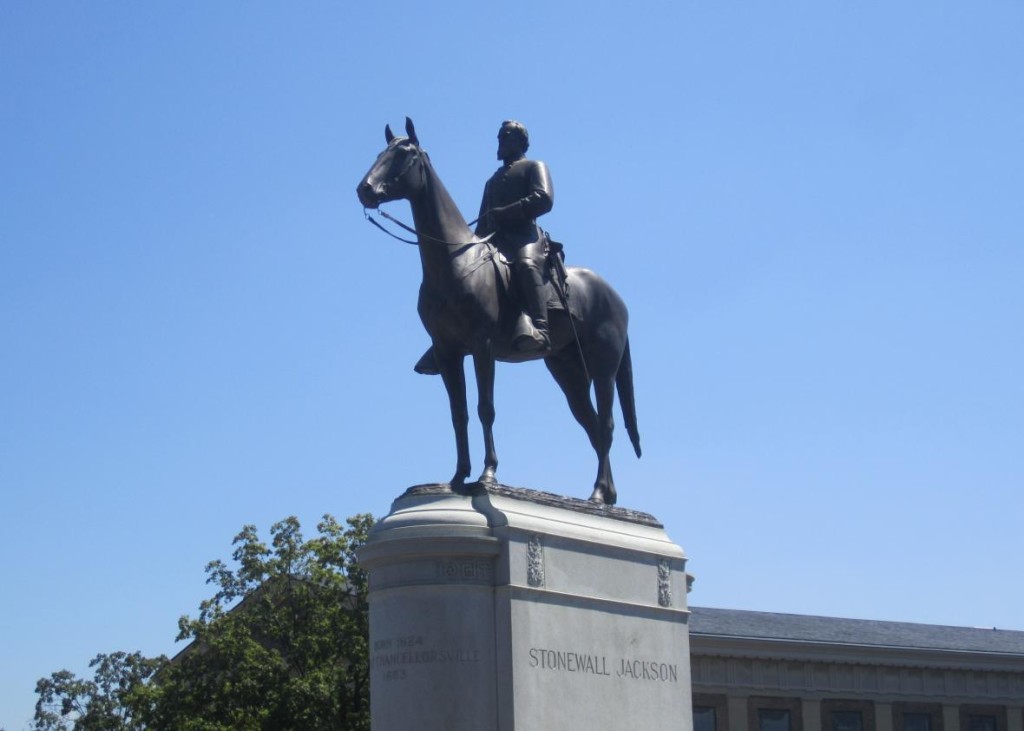 Stonewall Jackson statue, Richmond, Virginia (Slate/Billy Hathorn)
Stonewall Jackson statue, Richmond, Virginia (Slate/Billy Hathorn)
- ‘[T]he United States is not alone in struggling with monuments to a violent past. Many countries are obliged to constantly strike a balance between removing monuments that honor the reprehensible and maintaining them as sites of memory … Monuments are places where memory crystallizes. But what kind of memory that is, and who the memories belong to, depends on the context in which the monuments are placed. One of the most important considerations in these situations is the monument’s original intent.’ (Paul Cooper, Foreign Policy, 17 August 2017)
- ‘[S]hould statues that represent dark episodes in a country’s history be removed? Or should they be kept as reminders of trauma? … We keep the things that we love the most, but sometimes we also keep the things that remind us about the horror of the past. Monuments can echo the traumatic events that have shaped our culture, history and civilisation … Perhaps Charlottesville is the first of many cases in which societies will reevaluate past atrocities. Regardless of the outcome, it’s clear that monuments and statues will sometimes help determine the course of history.’ (
- ‘History, thick with all sorts of human exchange and perspectives, is actually never really finished business. It, like memory, is elastic. Successive generations view the past in new ways as alternative histories and stories come to prominence, while other stories fade from view.’ (Toni Hassan, Fairfax, 19 August 2017)
A couple of years ago, the Australian War Memorial faced the question of whether to remove or restore gargoyles depicting Indigenous Australians in a context that may have been appropriate to the 1930s (when the works were constructed) but was questionable today. Alfred L. Brophy in the American version of The Conversation summarises the history of monument removal in the United States. Another American roundup, this time of recent commentary, though a Tweet noted the lack of black historians in the list.
As all historians know, forgetting is as essential to public understandings of history as remembering. Confederate statues do not simply commemorate “our” history, as the president declared. They honor one part of our past. Where are the statues in the former slave states honoring the very large part of the Southern population (beginning with the four million slaves) that sided with the Union rather than the Confederacy? Where are the monuments to the victims of slavery or to the hundreds of black lawmakers who during Reconstruction served in positions ranging from United States senator to justice of the peace to school board official? Excluding blacks from historical recognition has been the other side of the coin of glorifying the Confederacy.
Historian Margaret Macmillan has written thoughtfully about these and related issues in a number of countries. Cartoonist First Dog on the Moon. Stan Grant on the ABC compares Australia’s tendency to leave its racist history in place with the American current preference to remove it.
One of the blessings of living in a democracy [says Natalie Nougayrède in The Guardian] is that researchers, students, journalists and citizens at large can all access the past without having to subject themselves to any form of centralised, censoring control … Yet the security of memory in democratic societies may not be as assured as we think. Some politicians want to lead us in a march towards forgetfulness. But that way lies a world of senselessness and deceit. Learning about history, and being able to question some of the narratives advanced in the name of politics is as important as knowing where to get reliable news.
Tourism academic Freya Higgins-Desbiolles from the University of South Australia discusses these issues in The Conversation. ‘It remains to be seen if we [in Australia] reconcile our past across dissonant heritages to derive a shared present and build a future together.’
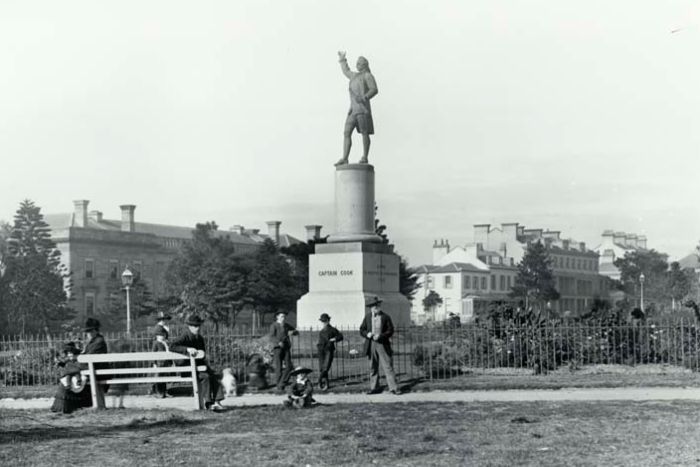 Captain Cook in Hyde Park, Sydney, not long after unveiling 1879 (ABC/NSW State Archives)
Captain Cook in Hyde Park, Sydney, not long after unveiling 1879 (ABC/NSW State Archives)
Succinct summing up by Sean Kelly in The Monthly Today:
The lesson here is pretty simple: our understanding of history changes all the time. Sometimes we learn new facts, which prove that what we thought we knew was wrong. Sometimes we learn that we have been looking at events from one perspective only. These new understandings of history are then written down. Sometimes they add to what we know. Sometimes they change what we know: in other words, replace it. Is history rewritten? Yes, all the time. If that were not the case we wouldn’t need historians …
Those who wish to “preserve” the past profess a deep passion for history, while making an argument that we should ignore actual history in favour of outdated, inaccurate history. We should be taught what we have always been taught, rather than what we now know to be the case. It is an argument for propaganda, a victory for the obscuring fog of nostalgia.
Honest History distinguished supporter Paul Daley says on the Guardian Australia website that statues of six particular Australian ‘heroes’ need rethinking. ‘We do not learn history from monuments and statues, but from interrogating and challenging them.’
The edits being discussed now are corrections. Our history has been written, controlled and ensured by colonial Englishmen. They had an agenda. The history they wrote was for their times, it was rigidly British. Times were markedly different. People in your parliament continue to fight to encourage an absurd and dishonest reading of history. It is time to correct the errors, call out the murderers and take the final proud steps through reconciliation.
ANU history professor, Bruce Scates, writing in The Conversation, looks at an example in Fremantle, WA, where an offensive and dishonest plaque was countered by an alternative view.
War memorials are a feature of the Australian landscape. Obelisk and arch, broken pillar and stone statue remind us of the crippling loss a young nation faced in campaigns overseas. But where are the monuments to conflicts fought in our own country – a brutal war of dispossession that left deep and enduring scars on countless communities? …
[S]anitised symbols of violence and dispossession have long stood unchallenged in the heart of our towns and cities. By occupying civic space they serve to legitimise narratives of conquest and dispossession, arguably colonising minds in the same ways white “settlers” seized vast tracts of territory …
Once the meanings of monuments were thought to be set in stone; now they crumble in the relentless critique of history.
Celeste Liddle, National Indigenous Organiser at the National Tertiary Education Union, responds vigorously in Guardian Australia to Andrew Bolt’s allegations about proponents of Aboriginal history being ‘cultural vandals’. ‘If recognising Aboriginal history amounts to “cultural vandalism”, then I know I’m proud of the councillors working in my area as I walk around the streets in my own Aboriginal flag-starred beret.’
Offensive place names in Queensland (using the term ‘Nigger’) are to be removed from new maps put out by the Queensland government. ‘I spoke to the Aboriginal Community leaders there and they were so offended because they had to walk across that bridge every day and they couldn’t understand why the name wasn’t changed.’ More.
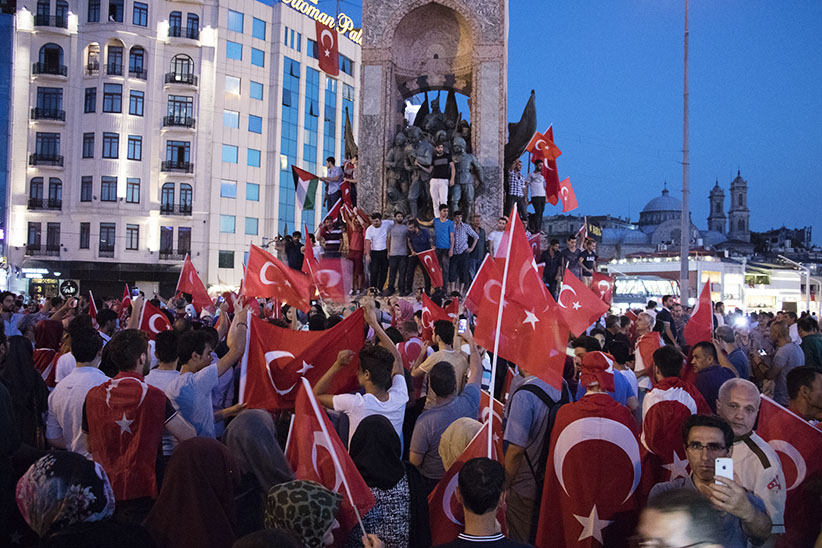
Adnan R. Khan, writing in the Canadian magazine, Maclean’s, wonders whether there is any point at all to building bricks and mortar memorials.
Since it was erected, the Republic Monument [in Taksim Square, Istanbul, picture above by Adnan Khan] has stood watch over Ataturk’s nation-building mission. Stone-faced, the man at its centre has come to mean different things to different people at different times, his place in history amended, like a repurposed meme, with every capricious permutation in the political landscape. Today, Turkey has moved away from Ataturk’s radically secular ideal. It has turned its face away from the west and is looking back to reclaim the glories of its Ottoman past.
But that could change again next week, or in a month from now, or in a decade. It will almost certainly change at some point in the future, if we are to believe the timeless adage that there is no constant in this world except change. And when the context changes again, so will the meaning of Ataturk.
That’s the problem with statues made in the likeness of men (and women, for that matter): even edified in stone, humans can never shake the ambiguity of being human. Their memories will be used by some to promote one vision of the world and by others to promote another. Despots and revisionists will take their legacies hostage, obscure the darkness, and shine light on whatever serves their purposes.
Steve Coll in the New Yorker looks at practice in India, particularly in relation to the monuments of British Imperial India but also of the immediate post-colonial era.
The Hindu right’s attack on such a foundational figure as Nehru signals the reach of its ambition to remake Indian nationalism through a majoritarian narrative. As Prem Shankar Jha, one of the old lions of Indian journalism, wrote this month in The Wire, Narendra Modi, the B.J.P. Prime Minister, “is intent upon changing the very idea of nationhood upon which India’s political identity has been based not just for the past seventy, but the past two thousand years.” The country’s sharp turn [in the Modi years] reminds us that the official revision of history in public spaces is at least as likely to be an illiberal project as an inclusive or cathartic one.
Warwick McFadyen in Daily Review says this:
History is often hostage to ideology. This is no more so apparent than in the defence of the realm put forward by former prime ministers John Howard and Tony Abbott, and the cohort of conservative commentators and the clutch of MPs who deem this history of ours, this imperfect rendering of the past, to be set in stone. It would be an exercise in self-destruction to allow an alternative interpretation of how we got where we are, and therefore who we are, to chip away at the foundations of their beliefs. Thus it does not, cannot happen. Riders, of course, come into the argument, such as “of course bad things were done, but the good outweighs the bad”. But in the end, the fallback position is: you cannot rewrite history.
Literally, this is true. No one is Marty McFly or HG Wells’ Time Traveller. But most of history is fluid because as more research is done, the shape of a time, an era, an event changes. Some things, some historical figures are incontrovertibly as they are. But over the vast horizon of history, few things are black and white and when the facts change, thus must opinion change to agree with the facts.
Every community and generation chooses which parts of its history to recall, which events are to be commemorated and which symbols should be used to remind us of our past. Updating our history to more correctly reflect reality should not be a problem for a mature country.
Frank Bongiorno, Honest History President, in Inside Story:
Denialism we will always be with us — some people still believe the moon landing was faked — but those defending colonial monuments don’t usually contend that Australia had a peaceful past, nor do they accuse historians who have suggested otherwise of telling fibs. That’s where we were fifteen years ago. The debate has moved on, partly because historians did what historians generally do best — carried out conscientious research in the primary sources — and partly because the political right lost interest. As a result, when my daughter learns about colonial history in primary school — or when I and my colleagues teach university students about Australian race relations — the story remains one characterised by violence and dispossession, as well as cooperation, friendship, love and much else that happens when two groups of human beings encounter one another in the real world.
Amy Clarke in The Conversation on the Big Banana and other super-sized tourist attractions around Australia, many of them now falling into disrepair. Clark does not explicitly make the comparison with war memorials and other historical monuments but someone should at some point.
Henry Reynolds in Pearls and Irritations compares how the United States has handled slavery with how Australia has dealt with the legacy of Indigenous dispossession.
The contention over American monuments reminds us the legacy of slavery lives on, as does the eloquent commitment in the Declaration of Independence to liberty and equality. Australia has a similar problem. We live with the consequences which derive from the manner in which the British annexed Australia with no recognition of pre-existing indigenous rights. The contradiction cemented into the foundations of the republic are easy for us to see. We have greater difficulty recognizing the structural flaws inherited from our founding documents.
There is an interesting comment by Jeremy Bentham on Australia and Reynolds notes forms of words used in New Mexico and Western Australia to explain how later generations have viewed – and reviewed – the memorialisation of earlier ones.
Don Watson in The Monthly and Tracey Spicer in Fairfax offer some sensible suggestions. Spicer asks why there are so few statues of women in Australia. Good question.
David Rieff is an American who has written about these issues. We posted some highlights here. Among other things, Rieff says this:
I am not prescribing moral amnesia here. To be wholly without memory would be to be without a world. Nor am I arguing against the determination for a group to memorialise its dead or demand acknowledgment of its sufferings. To do so would be to counsel a kind of moral and psychological self-mutilation of tragic proportions. On the other hand, too much forgetting is hardly the only risk. There is also too much remembering, and in the early 21st century, when people throughout the world are, in the words of the historian Tzvetan Todorov, “obsessed by a new cult, that of memory”, the latter seems to have become a far greater risk than the former.
Charlottesville also should have reminded us that the idea that history is a list of agreed and immutable facts is misleading and fatuous. Context and interpretation is everything. The past is something that we have all lived but it is remembered selectively, used and abused. Somewhere in that process there emerges history – histories. This is Larissa Behrendt, in her chapter in The Honest History Book:
History is not a single story. It is competing narratives, brought to life by different groups whose experiences are diverse and often challenge the dominant story a country seeks to tell itself. There are no absolute truths in history. It is a process, a conversation, a constantly altering story.
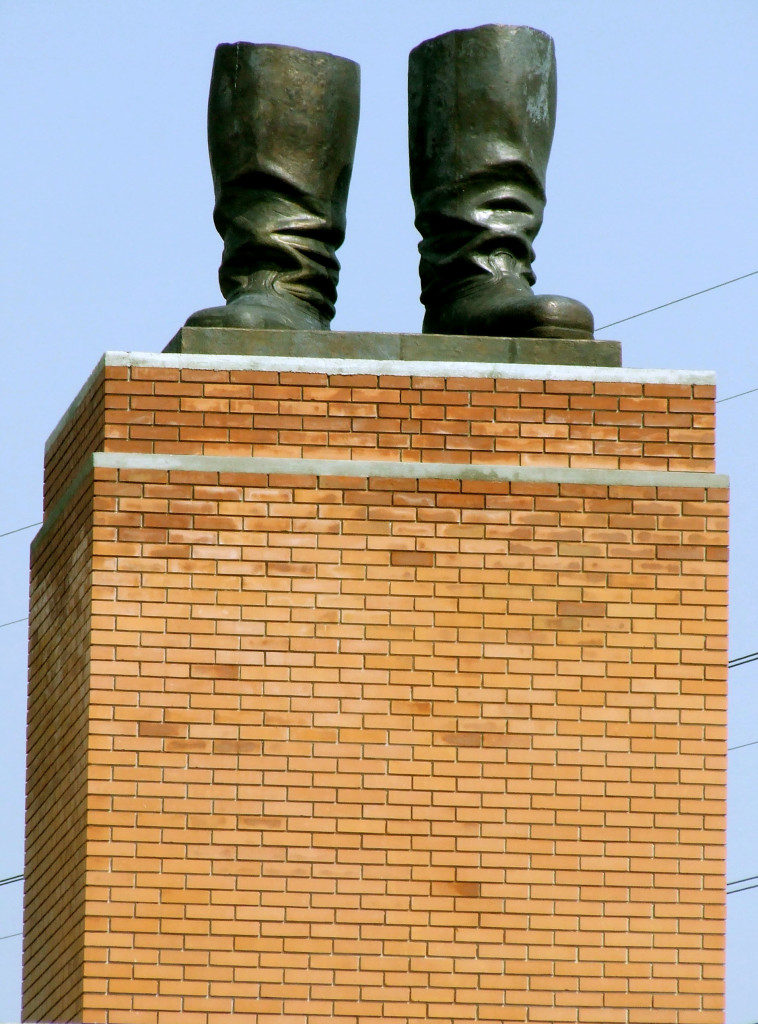 Stalin’s boots, Budapest, the remains of a statue pulled down in 1956 (Foreign Policy/Wikimedia/Ines Zgonc)
Stalin’s boots, Budapest, the remains of a statue pulled down in 1956 (Foreign Policy/Wikimedia/Ines Zgonc)
20 August 2017 updated


Well observed.